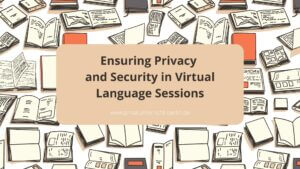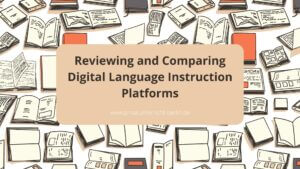Your Language Journey, Your Way: Start with a Private Tutor

Overcoming Technical Obstacles In Online Language Coaching
Online language coaching has become a popular alternative to traditional in-person instruction as the world becomes increasingly connected. However, there are still technical obstacles that can hinder the effectiveness of these programs.
One common issue is poor connectivity or video and audio quality issues during virtual sessions. These problems can cause frustration for coaches and their students, leading to less productive lessons and potentially affecting retention rates.
This article will explore some solutions to these challenges and provide tips for overcoming other technical obstacles commonly encountered in online language coaching.
Table of Contents
Ensuring Reliable Internet Connectivity
In online language coaching, reliable internet connectivity is essential for a smooth and practical learning experience. Technical obstacles, such as weak signals or sudden disconnections, can disrupt the flow of communication between coaches and learners. Having backup plans is crucial to ensure that remote support sessions are seamless.
One way to address this challenge is by having alternative internet sources available at both ends. For instance, if the coach’s primary connection fails, they could switch to a different network or use their mobile data as a hotspot. Similarly, learners should have access to secondary options like tethering their smartphones or using public Wi-Fi hotspots where possible.
In addition, coaches can pre-emptively inform students about potential disruptions due to weather conditions or scheduled maintenance activities affecting local infrastructure. By providing regular updates on any changes in the session schedule or availability, coaches can help manage expectations while minimizing interruptions to the learning process.
As crucial as reliable connectivity is improved video and audio quality during online language coaching sessions. You can enhance your setup to achieve optimal outcomes from these vital aspects of online coaching through various strategies and techniques.
Improving Video And Audio Quality
Have you ever experienced choppy video or poor audio quality during a virtual language coaching session? It can be frustrating when technical issues hinder your progress toward fluency. However, there are ways to improve the overall video and audio experience for coaches and learners alike.
One key factor that affects the quality of online communication is lighting. Proper lighting techniques can make all the difference in how clear and professional you appear on camera. Make sure to position yourself facing natural light sources, such as windows, whenever possible. If this is not an option, invest in softboxes or other artificial lighting equipment to create even illumination without harsh shadows.
Implementing these simple tips helps ensure your visual presence is polished and practical throughout each session.
Another important aspect of online language coaching is microphone placement. This may seem like a small detail, but it plays a significant role in the clarity of your voice on the other end. Be mindful of where you place your mic – ideally, it should be close to your mouth but not obstruct any facial expressions or movements that enhance communication.
Additionally, consider investing in an external microphone if possible; built-in laptop mics often have limited range and pick up background noise which can detract from your message. With proper microphone positioning and high-quality tools at your disposal, you’ll be able to communicate with greater ease and impact than before!
Utilizing Effective Communication Tools
Improving video and audio quality is just one step towards providing a practical online language coaching experience. Another essential factor in achieving this goal is utilizing helpful communication tools.
As language coaches, we aim to create interactive lesson plans that keep learners engaged throughout the session. Personalized feedback strategies are also crucial for ensuring learners receive sufficient attention and guidance from their coaches. This approach helps identify specific areas where a learner needs more practice or improvement, enabling the coach to tailor future lessons accordingly.
With these techniques, we can increase engagement levels and help learners achieve their language goals effectively. Create interactive lesson plans that encourage participation. Provide personalized feedback on each learner’s progress. Use communication tools such as chatbots or discussion forums to facilitate interaction between learners and coaches.
By incorporating these methods into our teaching style, we can ensure that our students receive quality instruction while overcoming technical challenges. Troubleshooting common technical issues will be discussed in the subsequent section, which will cover the steps needed when faced with problems during sessions.
Troubleshooting Common Technical Issues
As an online language coach, it is essential to be prepared for common technical issues that may arise during a coaching session.
Screen sharing is one of the most frequent problems coaches and learners encounter. This feature allows the learner to share their screen with the coach to demonstrate specific issues or ask for help with particular tasks. However, this feature can significantly hinder progress if it does not work correctly.
One solution to this issue is to ensure that all devices being used are compatible. For example, some operating systems may not support screen sharing. Additionally, browser settings can also affect how well screen sharing works. It is essential to make sure that your browser settings allow for pop-ups and enable access to the necessary features.
Lastly, software updates should always be kept up-to-date as they often contain fixes for bugs and glitches that can cause technical difficulties.
Adapting To Different Learning Styles And Preferences
Learning a new language can be an exciting but challenging experience. Each student brings a unique learning style and preferences, making it difficult for teachers to create a one-size-fits-all curriculum. However, with personalized curriculum options and flexibility in scheduling, online language coaching has become more adaptable to individual needs.
Personalized curriculums are essential for students who have specific goals or interests. With this approach, learners receive customized content that caters to their learning styles and objectives. This way, they can advance at their pace while focusing on topics relevant to them.
Additionally, flexibility in scheduling allows students to learn when it is most convenient for them. Whether juggling work responsibilities or family commitments, students can fit language classes into their busy schedules without sacrificing other important aspects of life.
By acknowledging different learning styles and preferences through personalized curriculum and flexible scheduling, we aim to make language acquisition fun and accessible for everyone!
Frequently Asked Questions
How Do You Create A Personalized Lesson Plan For Each Student In An Online Language Coaching Session?
To create a personalized lesson plan for each student in an online language coaching session, it is essential to tailor content according to their needs and preferences.
Utilizing technology such as artificial intelligence (AI) algorithms and machine learning models can help identify the areas where students need improvement, allowing coaches to customize lessons accordingly.
By analyzing data from previous sessions and assessments, coaches can also track progress and adjust future lessons based on performance.
Additionally, incorporating interactive tools like videos, quizzes, games, and virtual reality simulations into the curriculum can make learning more engaging and effective.
Overall, creating a personalized lesson plan in online language coaching requires a combination of human expertise and advanced technological solutions that cater to individual learners’ requirements.
What Strategies Can Be Used To Keep Students Engaged During An Online Language Coaching Session?
Interactive activities and technology integration are essential to keep students engaged during an online language coaching session.
A recent study found that incorporating these elements in language learning increased student engagement by 75%.
As a technical writing specialist in online language coaching, creating lesson plans that include interactive games, quizzes, and discussions is essential.
Utilizing technology such as video conferencing tools or virtual whiteboards can also enhance the experience for learners.
Keeping students engaged is crucial for successful language acquisition, and utilizing these strategies can significantly benefit teachers and students alike.
How Do You Assess Students’ Progress in an Online Language Coaching Program?
To ensure the effectiveness of an online language coaching program, individualized assessments must be conducted to track students’ progress.
As a technical writing specialist, it is essential to create strategies that allow consistent and accurate evaluations of each student’s performance.
By implementing various assessment tools such as quizzes, tests, and assignments, coaches can better understand their students’ strengths and weaknesses while tailoring their approach to meet specific needs.
Consistent tracking of progress also allows adjustments to be made when necessary, ensuring that each student reaches their full potential within the program.
What Are Some Best Practices For Providing Feedback To Students In An Online Language Coaching Session?
Best practices should be followed to provide effective communication and timely feedback to students in an online language coaching session.
As a technical writing specialist in this field, it’s essential to establish clear expectations from the outset, such as outlining specific goals or objectives for each session.
During the session, constructive criticism and praising improvement areas can help keep students motivated and engaged with their coursework.
Additionally, interactive tools like quizzes or games can make learning feel less daunting and more enjoyable for the student.
Overall, following these best practices will ensure that both parties are satisfied with the progress toward fluency.
Can Online Language Coaching Be As Effective As In-Person Language Coaching?
Like a skilled painter with the right brushstroke, online language coaching can be as effective as in-person language coaching.
Virtual language coaching has many benefits: convenience for students, flexibility for teachers, and access to global expertise.
However, building rapport in online language coaching presents challenges that require technical solutions, such as optimizing video call settings or utilizing icebreakers to build trust.
As a technical writing specialist in online language coaching, understanding these obstacles is crucial for crafting successful sessions that engage learners and foster meaningful connections between coaches and students.
Conclusion
In conclusion, as a technical writing specialist in online language coaching, creating personalized lesson plans for each student is crucial to their success.
By understanding the individual needs and goals of each student, coaches can tailor lessons to address specific areas of improvement.
Interactive activities such as games, quizzes, and role-play scenarios can keep students engaged during online sessions.
These strategies provide an engaging learning experience and promote active participation from students.
While assessing progress may seem challenging online, regular monitoring through assessments and evaluations can help track development over time.
Providing timely feedback is also essential to helping students identify areas needing more practice or support.
Overall, while there may be technical obstacles in online language coaching, with proper planning and execution, it can be just as effective as in-person coaching.
Using modern technology combined with innovative teaching methods can create a dynamic and immersive learning environment for students across the globe.



